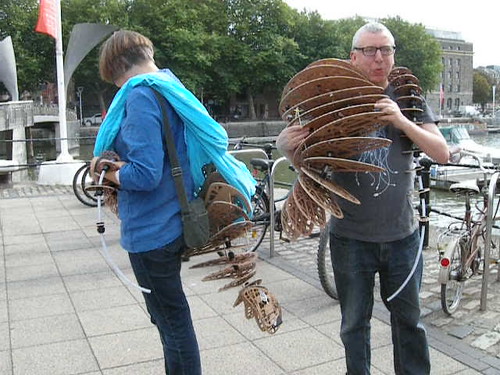Prototyping for loneliness
After a few days a while ago finding my feet, I’ve been back at the Pervasive Media Studio in Bristol getting started on the next wave of development of Colony – the walking experience I’m developing that involves a group of landscape-reactive animatronic ‘critters’ being carried through the city.
I was here in the summer of 2014 for a previous residency working on the project, and it was so productive that I’m back again as part of another batch of R&D activities – thanks to Arts Council for funding both of these residencies.
Last time around I arrived at an interesting design for the physical form of the critters and we did some playtesting to get a feel for how people responded both to this and the behaviour we (Tarim and I) had programmed in response to the interaction of GPS radio waves interacting with the built environment.
Last time the question was “can you see the sky?”; this time it’s “can you see your friends?”

Again working with Tarim, we’ve been working on the second strand of critter behaviour to do with how connected they are to the rest of the colony. We’re using XBee radio modules to set up a communication network amongst the colony so each critter can monitor how long it’s been since it last heard each of the other critters announce their presence. If it goes quiet for too long, loneliness sets in and the person carrying the critter will have to hurry to rejoin the rest of the group.

That’s the plan, anyway. For the last couple of days we’ve been using breadboarded prototypes to get a feel for how this might play out in practice.
First tests involved a couple of LEDs and me wandering up and down the PM Studio corridor in a slightly shifty manner looking for when the connection between two radios was lost.

Yesterday we scaled things up to five prototype boards and many LEDs!
After more odd behaviour in the corridor (the sacrifices I make for my art!) and a quick venture outside, we gathered a team of volunteers to get a feel for how things might be with a group of people.

We gave ourselves a basic rule-set: scatter until you have only one LED lit (but try try not to lose all of them and become totally disconnected from the group) and then try and link up with everyone again. We were curious about how attenuated the group might get in the urban environment and what sort of shape it might take at that point. We were also wondering about what might happen at that inflection where some of the colony were still trying to get down to one light whilst others had already started to seek out more companions again.

Our first test was in amongst the Watershed buildings along the harbourside, so quite linear (although I did see Tarim heading down a jetty at one point!), so then we went around the corner to Millennium Square and a big open space. We all radiated out to get away from each other, but even at the edge of the open space we were still within range and had most LEDs lit. Then it got interesting with people ducking behind vans and nipping into buildings to try and block the signal radio waves. We liked that!
Testing! We've also been prototyping the next generation of 'Colony' critters w/ @nikkipugh https://t.co/273rL3wCUn pic.twitter.com/2Yy1Bt2AGi
— PervasiveMediaStudio (@PMStudioUK) February 9, 2016
All in all the first experiments have been very positive. We’re discovering some quirks of the XBee system – of course – but there’s a definite sense that we can translate the behaviour of the radio modules into something that can be read as loneliness. Mostly I’m super happy to have caught a glimpse of an actual colony moving through the streets.
I’m going to build up a few more prototypes, we’re going to tweak the code and the feedback system and then, next time I’m in Bristol, I think we’re going to run another playtest where we observe how people move between two pre-determined points. Stay tuned…
